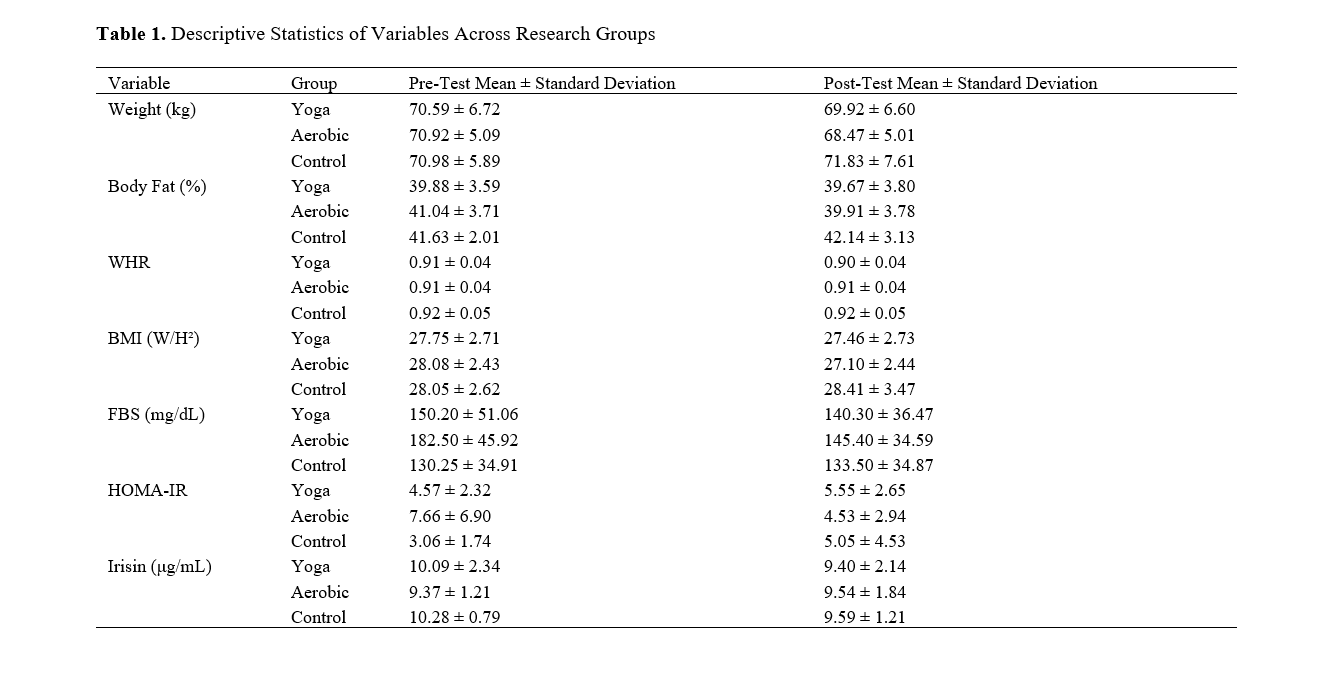Comparison of the Effects of Yoga Exercises and Moderate-Intensity Aerobic Training on Irisin and Insulin Resistance in Women with Type 2 Diabetes
Keywords:
Irisin, Diabetes, Yoga, Diabetic PatientsAbstract
Objective: The present study examines the Comparison of the Effects of Yoga Exercises and Moderate-Intensity Aerobic Training on Irisin and Insulin Resistance in Women with Type 2 Diabetes.
Materials and Methods: Thirty middle-aged diabetic women with a mean age of 53.0 ± 4.31 years, height of 159.3 ± 4.54 cm, and weight of 70.8 ± 5.72 kg were randomly assigned to three groups: yoga exercise (experimental group 1), aerobic training (experimental group 2), and control. The aerobic training group performed a program consisting of three 60-minute sessions per week at an intensity of 60–70% of maximum heart rate, using light weights to simulate a combined protocol. Each session included 10 minutes of warm-up and 20 minutes of cool-down with stretching and flexibility exercises. Yoga training sessions were conducted three times a week for 60 minutes under the supervision of experienced instructors. The principle of overload was applied in the yoga protocol by increasing repetitions from 3 sets over 9 minutes in the first session to 9 sets, while rest periods were reduced, and exercise intensity was increased. Participants were advised to refrain from engaging in any other physical activity during the 12-week intervention.
Findings: In the interaction effect between groups and time, although weight and body fat percentage decreased in both training groups, the difference between groups was not statistically significant. No significant difference was observed in serum fasting blood sugar (FBS) levels among obese women with type 2 diabetes (P ≥ 0.05). Changes in HOMA-IR levels across the groups (P = 0.67) and measurement times (P = 0.18) in the control, aerobic, and yoga groups were also not significant. The interaction effect of group and time on serum irisin levels in diabetic women showed no significant changes (P = 0.67), though serum irisin levels increased in the aerobic group. However, the time effect from pre- to post-test among groups (P = 0.70) and the between-group effects were not statistically significant (P ≥ 0.05).
Conclusion: Although the effects of the exercises were not statistically significant, considering the increased interest of patients in performing both exercises, especially yoga, these exercises can be used as complementary training for diabetic patients.
Downloads
References
1. Campbell MD, Sathish T, Zimmet PZ. Benefit of
lifestyle-based T2D M prevention is influenced by prediabetes
phenotype. Nature Reviews Endocrinology. 2020;16:395-400.
[PMID: 32060416] [DOI]
2. Campbell MD. Benefit of lifestyle-based T2D M
prevention is influenced by prediabetes phenotype. Nature Reviews
Endocrinology. 2020;16:395-400. [PMID: 32060416] [DOI]
3. Cloete L. Diabetes mellitus: An overview of the types,
symptoms, complications and management. Nursing Standard.
2022;37(1):61-6. [DOI]
4. Kim US, Nam JS, Yeo DW. The effects of aerobic
exercise training on serum osteocalcin, adipocytokines and insulin
resistance on obese young males. Clinical Endocrinology.
2014;82(5):686-94. [PMID: 25174991] [DOI]
5. Cicek MA, Tuygar Okutucu F, Ozturk N. Irisin, adropin,
and preptin as biomarkers of energy dysregulation in depressive
disorder. Current Medical Research and Opinion.
2023;39(9):1263-70. [PMID: 34708622] [DOI]
6. Boström P, Wu J, Jedrychowski MP. A PGC1αdependent myokine that drives brown-fat-like development of
white fat and thermogenesis. Nature. 2012;481(7382):463-8.
[PMID: 22237023] [PMCID: PMC3522098] [DOI]
7. Stengel A, Hofmann T, Goebel-Stengel M, Elbelt U,
Kobelt P, Klapp BF. Circulating levels of irisin in patients with
anorexia nervosa and different stages of obesity: Correlation with
body mass index. Peptides. 2013;39:125-30. [PMID: 23219488]
[DOI]
8. Bonfante ILP, Monfort-Pires M, Duft RG, Mateus
KCDS, Júnior JCDL, Trombeta JCDS, et al. Combined training
increases thermogenic fat activity in patients with overweight and
type 2 diabetes. International Journal of Obesity. 2022;46:1145-54.
[PMID: 35173278] [DOI]
9. Norheim F, Langleite TM, Hjorth M. The effects of acute
and chronic exercise on PGC-1α, irisin and browning of
subcutaneous adipose tissue in humans. FEBS Journal.
2014;281(3):739-49. [PMID: 24237962] [DOI]
10. Hakimi M, Attarzade Hosseini S. The Changes of Irisin
Serum Levels and Lipid Profile of Overweight Male Students after
Eight Weeks of Aerobic Training. The Journal of Shahid Sadoughi
University of Medical Sciences. 2016;23(12):1189-201.
11. Kurdiova T, Balaz M, Vician M, Maderova D, Vlcek M,
Valkovic L. Effects of obesity, diabetes and exercise on Fndc5 gene
expression and irisin release in human skeletal muscle and adipose
tissue: in vivo and in vitro studies. The Journal of Physiology.
2014;592(5):1091-107. [PMID: 24297848] [PMCID:
PMC3948565] [DOI]
12. Pekkala S, Wiklund PK, Hulmi JJ, Ahtiainen JP,
Horttanainen M, Pöllänen E. Are skeletal muscle FNDC5 gene
expression and irisin release regulated by exercise and related to
health? The Journal of Physiology. 2013;591(21):5393-400.
[PMID: 24000180] [PMCID: PMC3936375] [DOI]
13. Kumar Singh A, Kaur N, Kaushal S, Tyagi R, Mathur D,
Sai Sivapuram M, et al. Partitioning of radiological, stress and
biochemical changes in pre-diabetic women subjected to Diabetic
Yoga Protocol. Diabetes & Metabolic Syndrome: Clinical
Research & Reviews. 2019;13:2705-13. [PMID: 31405697] [DOI]
14. Aydin S, Kilinc F, Ugur K, Aydin MA, Yalcin MH,
Kuloglu T, et al. Effects of irisin and exercise on adropin and
betatrophin in a new metabolic syndrome model. Biotechnic &
Histochemistry. 2023;99(1):21-32. [PMID: 37933453] [DOI]
15. Enteshary M, Esfarjani F, Reisi J. Comparison of the
effects of two different intensities of combined training on irisin,
betatrophin, and insulin levels in women with type 2 diabetes.
Asian Journal of Sports Medicine. 2019;10(2). [DOI]
16. Tsuchiya Y, Ando D, Goto K, Kiuchi M, Yamakita M,
Koyama K. High-intensity exercise causes greater irisin response
compared with low-intensity exercise under similar energy
consumption. The Tohoku Journal of Experimental Medicine.
2014;233(2):135-40. [PMID: 24910199] [DOI]
17. Baradaran H, Rahmaninia F, Elmieh A. Effects of 8-
week combined training (aerobic and resistance) on serum levels of
irisin and leptin in overweight men. Daneshvar Medicine.
2020;28(4):10-22.
18. Ramezankhani A, Soori R. The Effect of 16 Weeks of
Low-Calorie Diet on Irisin Serum Levels and Insulin Resistance
Index in Obese Sedentary Women. Journal of Food Technology
and Nutrition. 2017;14(2):99-106.
19. D’Amuri A, Raparelli V, Sanz JM, Capatti E, Di Vece F,
Vaccari F. Biological response of irisin induced by different types
of exercise in obese subjects: A non-inferiority controlled
randomized study. Biology. 2022;11(3):392. [PMID: 35336766]
[PMCID: PMC8945525] [DOI]
20. Parada-Sánchez SG, Macias-Cervantes MH, PérezVázquez V, Vargas-Ortiz K. The effects of different types of
exercise on circulating irisin levels in healthy individuals and in
people with overweight, metabolic syndrome, and type 2 diabetes.
Physiological Research. 2022;71(4). [PMID: 35770469] [PMCID:
PMC9616589] [DOI]

Downloads
Additional Files
Published
Issue
Section
License
Copyright (c) 2024 Dahshti Abbas Mohammed Al Jammoor, Rahman Soori, Parisa Pournemati (Author)

This work is licensed under a Creative Commons Attribution-NonCommercial 4.0 International License.







